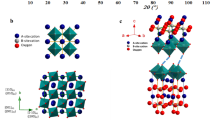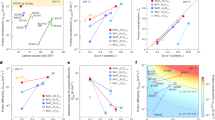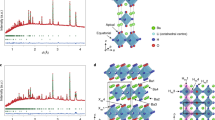Abstract
Proton conduction in hydrogen-bond-rich protic electrolytes enables fast mass and charge transport, crucial for electrochemical energy storage and power conversion. Such transport can give proton-based batteries exceptional rate capability and low-temperature operation beyond other working ions. Here we show that in phosphoric acid (H3PO4) electrolytes, vehicular and structural proton transport coexist, and their contributions to conductivity can be quantitatively distinguished. We link structural diffusion directly to hydrogen-bond strength, enabling the precise tuning of proton migration. Guided by this, we reveal a double conductivity peak from regulated structural diffusion. The optimal electrolyte (5.8-M H3PO4) achieves high overall (232.9 mS cm−1) and structural (164.9 mS cm−1) conductivity. A MoO3‖CuFe-TBA battery with this electrolyte outperforms a deep-eutectic benchmark (8.3-M H3PO4), delivering >17,474 W kg−1 at room temperature and retaining 15.1 Wh kg−1 at −75 °C. These findings provide a framework for designing advanced protic electrolytes across electrochemical systems.
This is a preview of subscription content, access via your institution
Access options
Access Nature and 54 other Nature Portfolio journals
Get Nature+, our best-value online-access subscription
$32.99 / 30 days
cancel any time
Subscribe to this journal
Receive 12 print issues and online access
$259.00 per year
only $21.58 per issue
Buy this article
- Purchase on SpringerLink
- Instant access to full article PDF
Prices may be subject to local taxes which are calculated during checkout





Similar content being viewed by others
Data availability
All data are available in the article or Supplementary Information. All experimental data reported in this study and Supplementary Information are available from the corresponding authors upon request. Source data are provided with this paper.
References
Carlson, C. E. The proton radius puzzle. Prog. Part. Nucl. Phys. 82, 59–77 (2015).
Agmon, N. et al. Protons and hydroxide ions in aqueous systems. Chem. Rev. 116, 7642–7672 (2016).
Musset, B. et al. Aspartate 112 is the selectivity filter of the human voltage-gated proton channel. Nature 480, 273–277 (2011).
Merte, L. R. et al. Water-mediated proton hopping on an iron oxide surface. Science 336, 889–893 (2012).
Foglia, F. et al. Disentangling water, ion and polymer dynamics in an anion exchange membrane. Nat. Mater. 21, 555–563 (2022).
Jiang, H. et al. Insights on the proton insertion mechanism in the electrode of hexagonal tungsten oxide hydrate. J. Am. Chem. Soc. 140, 11556–11559 (2018).
Decoursey, T. E. Voltage-gated proton channels and other proton transfer pathways. Physiol. Rev. 83, 475–579 (2003).
Tian, Y. et al. Visualizing Eigen/Zundel cations and their interconversion in monolayer water on metal surfaces. Science 377, 315–319 (2022).
Wendt, S. et al. Formation and splitting of paired hydroxyl groups on reduced TiO2(110). Phys. Rev. Lett. 96, 066107 (2006).
Wang, S. et al. Acid-in-clay electrolyte for wide-temperature-range and long-cycle proton batteries. Adv. Mater. 34, e2202063 (2022).
Li, Z. et al. Localized water restriction in ternary eutectic electrolytes for ultra-low temperature hydrogen batteries. Angew. Chem. Int. Ed. 64, e202416800 (2025).
Kreuer, K.-D., Rabenau, A. & Weppner, W. Vehicle mechanism, a new model for the interpretation of the conductivity of fast proton conductors. Angew. Chem. Int. Ed. 21, 208–209 (1982).
Agmon, N. The Grotthuss mechanism. Chem. Phys. Lett. 244, 456–462 (1995).
Ding, M. S., Von Cresce, A. & Xu, K. Conductivity, viscosity, and their correlation of a super-concentrated aqueous electrolyte. J. Phys. Chem. C 121, 2149–2153 (2017).
Yan, L. et al. Solid-state proton battery operated at ultralow temperature. ACS Energy Lett. 5, 685–691 (2020).
Yue, F. et al. An ultralow temperature aqueous battery with proton chemistry. Angew. Chem. Int. Ed. 60, 13882–13886 (2021).
Melchior, J. P., Kreuer, K. D. & Maier, J. Proton conduction mechanisms in the phosphoric acid-water system (H4P2O7–H3PO4·2H2O): a 1H, 31P and 17O PFG-NMR and conductivity study. Phys. Chem. Chem. Phys. 19, 587–600 (2016).
Vilčiauskas, L., Tuckerman, M. E., Bester, G., Paddison, S. J. & Kreuer, K.-D. The mechanism of proton conduction in phosphoric acid. Nat. Chem. 4, 461–466 (2012).
Ogawa, T., Kamiguchi, K., Tamaki, T., Imai, H. & Yamaguchi, T. Differentiating Grotthuss proton conduction mechanisms by nuclear magnetic resonance spectroscopic analysis of frozen samples. Anal. Chem. 86, 9362–9366 (2014).
Ogawa, T. et al. The proton conduction mechanism in a material consisting of packed acids. Chem. Sci. 5, 4878–4887 (2014).
Chung, S. H., Bajue, S. & Greenbaum, S. G. Mass transport of phosphoric acid in water: a 1H and 31P pulsed gradient spin-echo nuclear magnetic resonance study. J. Chem. Phys. 112, 8515–8521 (2000).
Aihara, Y., Sonai, A., Hattori, M. & Hayamizu, K. Ion conduction mechanisms and thermal properties of hydrated and anhydrous phosphoric acids studied with 1H, 2H, and 31P NMR. J. Phys. Chem. B 110, 24999–25006 (2006).
Vilčiauskas, L., Tuckerman, M. E., Melchior, J. P., Bester, G. & Kreuer, K.-D. First principles molecular dynamics study of proton dynamics and transport in phosphoric acid/imidazole (2:1) system. Solid State Ion. 252, 34–39 (2013).
Krueger, R. A., Vilciauskas, L., Melchior, J. P., Bester, G. & Kreuer, K. D. Mechanism of efficient proton conduction in diphosphoric acid elucidated via first-principles simulation and NMR. J. Phys. Chem. B 119, 15866–15875 (2015).
Paolantoni, M., Sassi, P., Morresi, A. & Santini, S. Hydrogen bond dynamics and water structure in glucose-water solutions by depolarized Rayleigh scattering and low-frequency Raman spectroscopy. J. Chem. Phys. 127, 024504 (2007).
Rudolph, W. W. Raman- and infrared-spectroscopic investigations of dilute aqueous phosphoric acid solutions. Dalton Trans. 39, 9642–9653 (2010).
Melchior, J. P. & Frick, B. On the nanosecond proton dynamics in phosphoric acid-benzimidazole and phosphoric acid-water mixtures. Phys. Chem. Chem. Phys. 19, 28540–28554 (2017).
Mikalčiūtė, A. & Vilčiauskas, L. Insights into the hydrogen bond network topology of phosphoric acid and water systems. Phys. Chem. Chem. Phys. 23, 6213–6224 (2021).
Ludueña, G. A., Kühne, T. D. & Sebastiani, D. Mixed Grotthuss and vehicle transport mechanism in proton conducting polymers from ab initio molecular dynamics simulations. Chem. Mater. 23, 1424–1429 (2011).
Mo, F. et al. Biomimetic organohydrogel electrolytes for high-environmental adaptive energy storage devices. EcoMat 1, e12008 (2019).
Greenwood, N. N. & Thompson, A. The mechanism of electrical conduction in fused phosphoric and trideuterophosphoric acids. J. Chem. Soc. 3485, 3492 (1959).
Xue, Z., Qin, L., Jiang, J., Mu, T. & Gao, G. Thermal, electrochemical and radiolytic stabilities of ionic liquids. Phys. Chem. Chem. Phys. 20, 8382–8402 (2018).
Huang, Z. et al. Anion chemistry in energy storage devices. Nat. Rev. Chem. 7, 616–631 (2023).
Simon, S. L. Temperature-modulated differential scanning calorimetry: theory and application. Thermochim. Acta 374, 55–71 (2001).
Bogdan, A., Molina, M. J. & Tenhu, H. Freezing and glass transitions upon cooling and warming and ice/freeze-concentration-solution morphology of emulsified aqueous citric acid. Eur. J. Pharm. Biopharm. 109, 49–60 (2016).
Sun, Q. The single donator-single acceptor hydrogen bonding structure in water probed by Raman spectroscopy. J. Chem. Phys. 132, 054507 (2010).
Cherif, M., Mgaidi, A., Ammar, N. & Vallee, G. A new investigation of aqueous orthophosphoric acid speciation using Raman spectroscopy. J. Solut. Chem. 29, 255–269 (2000).
Sun, Q. The Raman OH stretching bands of liquid water. Vib. Spectrosc. 51, 213–217 (2009).
Falk, M. & Giguère, P. A. Infrared spectrum of the H3O+ ion in aqueous solutions. Can. J. Chem. 35, 1196–1204 (1957).
Elmore, K. L., Hatfield, J. D., Dunn, R. L. & Jones, A. D. Dissociation of phosphoric acid solutions at 25°. J. Phys. Chem. 69, 3520–3525 (1965).
Rudolph, W. W. Raman-spectroscopic measurements of the first dissociation constant of aqueous phosphoric acid solution from 5 to 301 °C. J. Solut. Chem. 41, 630–645 (2012).
Suwannakham, P., Chaiwongwattana, S. & Sagarik, K. Proton dissociation and transfer in hydrated phosphoric acid clusters. Int. J. Quantum Chem. 115, 486–501 (2015).
Tyrrell, H. J. V. & Harris, K. R. Diffusion in Liquids: A Theoretical and Experimental Study (Butterworth-Heinemann, 2013).
Donald, W. A. et al. Directly relating reduction energies of gaseous Eu(H2O)n3+, n = 55–140, to aqueous solution: the absolute SHE potential and real proton solvation energy. J. Am. Chem. Soc. 131, 13328–13337 (2009).
Batchelor, G. K. Brownian diffusion of particles with hydrodynamic interaction. J. Fluid Mech. 74, 1–29 (1976).
Verma, A. K., Thorat, A. S. & Shah, J. K. Estimating ionic conductivity of ionic liquids: Nernst–Einstein and Einstein formalisms. J. Ion. Liq. 4, 100089 (2024).
Chengfa Jiang Thermodynamics of aqueous phosphoric acid solution at 25 °C. Chem. Eng. Sci. 51, 689–693 (1996).
Lu, N. et al. Enhanced low-temperature proton conductivity in hydrogen-intercalated brownmillerite oxide. Nat. Energy 7, 1208–1216 (2022).
Zhu, Z. et al. An ultrafast and ultra-low-temperature hydrogen gas-proton battery. J. Am. Chem. Soc. 143, 20302–20308 (2021).
Jiang, H. et al. A high-rate aqueous proton battery delivering power below −78 °C via an unfrozen phosphoric acid. Adv. Energy Mater. 10, 2000968 (2020).
Dalvit, C., Veronesi, M. & Vulpetti, A. 1H and 19F NMR chemical shifts for hydrogen bond strength determination: correlations between experimental and computed values. J. Magn. Reson. Open 12–13, 100070 (2022).
Li, W. et al. Designing ternary hydrated eutectic electrolyte capable of four-electron conversion for advanced Zn–I2 full batteries. Energy Environ. Sci. 16, 4502–4510 (2023).
Geng, L. et al. Eutectic electrolyte with unique solvation structure for high-performance zinc-ion batteries. Angew. Chem. Int. Ed. 61, e202206717 (2022).
Wu, X. et al. Diffusion-free Grotthuss topochemistry for high-rate and long-life proton batteries. Nat. Energy 4, 123–130 (2019).
Jayalakshmi, M. & Scholz, F. Performance characteristics of zinc hexacyanoferrate–Prussian blue and copper hexacyanoferrate–Prussian blue solid state secondary cells. J. Power Sources 87, 37–45 (2000).
Wessells, C. D., Huggins, R. A. & Cui, Y. Copper hexacyanoferrate battery electrodes with long cycle life and high power. Nat. Commun. 2, 550 (2011).
Machida, K. & Enyo, M. Structural and electrochromic properties of tungsten and molybdenum trioxide electrodes in acidic media. J. Electrochem. Soc. 137, 1169–1175 (1990).
Farneth, W. E., McCarron, E. M., Sleight, A. W. & Staley, R. H. A comparison of the surface chemistry of two polymorphic forms of molybdenum trioxide. Langmuir 3, 217–223 (1987).
Wang, J., Polleux, J., Lim, J. & Dunn, B. Pseudocapacitive contributions to electrochemical energy storage in TiO2 (anatase) nanoparticles. J. Phys. Chem. C 111, 14925–14931 (2007).
Miller, J. R. & Simon, P. Electrochemical capacitors for energy management. Science 321, 651–652 (2008).
Simon, P. & Gogotsi, Y. Charge storage mechanism in nanoporous carbons and its consequence for electrical double layer capacitors. Philos. Trans. R. Soc. A 368, 3457–3467 (2010).
Mayo, S. L., Olafson, B. D. & Goddard, W. A. DREIDING: a generic force field for molecular simulations. J. Phys. Chem. 94, 8897–8909 (1990).
Rappe, A. K. & Iii, W. A. G. Charge equilibration for molecular dynamics simulations. J. Phys. Chem. 95, 3358–3363 (1991).
Nosé, S. A molecular dynamics method for simulations in the canonical ensemble. Mol. Phys. 52, 255–268 (1983).
Berendsen, H. J. C., Postma, J. P. M., Gunsteren, W. F., van, DiNola, A. & Haak, J. R. Molecular dynamics with coupling to an external bath. J. Chem. Phys. 81, 3684–3690 (1984).
Delley, B. From molecules to solids with the DMol3 approach. J. Chem. Phys. 113, 7756–7764 (2000).
Delley, B. An all-electron numerical method for solving the local density functional for polyatomic molecules. J. Chem. Phys. 92, 508–517 (1990).
Perdew, J. P., Burke, K. & Ernzerhof, M. Generalized gradient approximation made simple. Phys. Rev. Lett. 77, 3865–3868 (1996).
Tkatchenko, A. & Scheffler, M. Accurate molecular van der Waals interactions from ground-state electron density and free-atom reference data. Phys. Rev. Lett. 102, 073005 (2009).
Klamt, A. & Schuurmann, G. COSMO: a new approach to dielectric screening in solvents with explicit expressions for the screening energy and its gradient. J. Chem. Soc. Perkin Trans. 2, 799–805 (1993).
Acknowledgements
We thank F. Wang and X. Qu for technical support. This work was supported by the National Natural Science Foundation of China (numbers 52261135631 and 52103335, F.W.; number 52071083, F.F.), the Science and Technology Commission of Shanghai Municipality (number 23TS1401700, F.W.), the Shanghai Pilot Program for Basic Research—Fudan University 21TQ1400100(25TQ012) (F.W.) and the Shanghai International Science and Technology Partnership Project (number 23520750400, F.W.). Work at Hunter College was supported by the US Department of Energy, Office of Science, Basic Energy Sciences, Energy Frontier Research Center ‘Breakthrough Electrolytes for Energy Storage (BEES)’ (Award DE-SC0019409, S.G.G.). Work at the School of Physics and Electronic Engineering was supported by the National Natural Science Foundation of China (number 52202245, Y. Lin), the Natural Science Fund for Colleges and Universities in Jiangsu Province (number 22KJB430004, Y. Lin) and the Jiangsu Special-Term Professor Program (Y. Lin). Work at Zhejiang Laboratory was supported by the Beforehand Research Project of the New Materials Computing Research Center (number 3700-32601, Y. Li).
Author information
Authors and Affiliations
Contributions
Conceptualization: Z.L., F.W., K.X., S.G.G. Methodology: Z.L., Y. Lin, M.N.G., Y. Li. Investigation: Z.L., F.W., M.N.G., M.L., Q.L. Visualization: Z.L., F.W., F.F., J.R., Y. Lin. Funding acquisition: F.W., F.F., D.S., S.G.G. Project administration: Z.L., F.W., S.G.G. Supervision: F.W., D.S., F.F., S.G.G. Writing—original draft: Z.L., K.X. Writing—review and editing: F.W., K.X., F.F., D.S.
Corresponding authors
Ethics declarations
Competing interests
The authors declare no competing interests.
Peer review
Peer review information
Nature Materials thanks the anonymous reviewers for their contribution to the peer review of this work.
Additional information
Publisher’s note Springer Nature remains neutral with regard to jurisdictional claims in published maps and institutional affiliations.
Supplementary information
Supplementary Information
Supplementary Notes 1–3, Figs. 1–30, Tables 1–5 and References.
Source data
Source Data Fig. 1
Raw numerical values for all plots.
Source Data Fig. 2
Raw numerical values for all plots.
Source Data Fig. 3
Raw numerical values for all plots.
Source Data Fig. 4
Raw numerical values for all plots.
Source Data Fig. 5
Raw numerical values for all plots.
Rights and permissions
Springer Nature or its licensor (e.g. a society or other partner) holds exclusive rights to this article under a publishing agreement with the author(s) or other rightsholder(s); author self-archiving of the accepted manuscript version of this article is solely governed by the terms of such publishing agreement and applicable law.
About this article
Cite this article
Li, Z., Lin, Y., Garaga, M.N. et al. Quantitative and mechanistic insights into proton dynamics for fast energy storage. Nat. Mater. (2025). https://doi.org/10.1038/s41563-025-02366-9
Received:
Accepted:
Published:
DOI: https://doi.org/10.1038/s41563-025-02366-9



